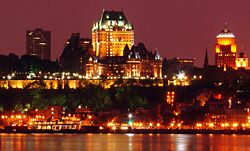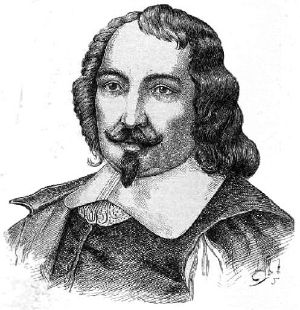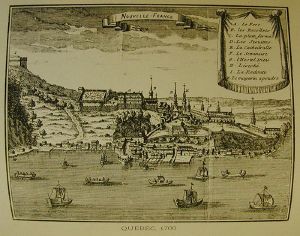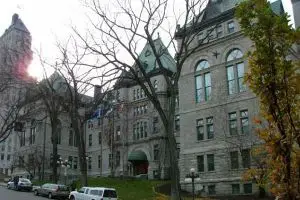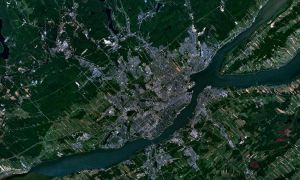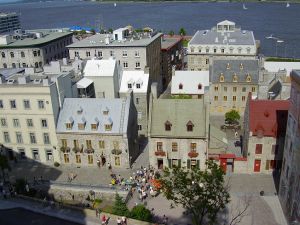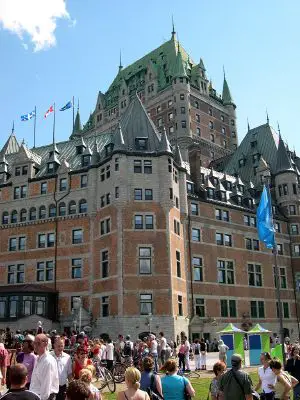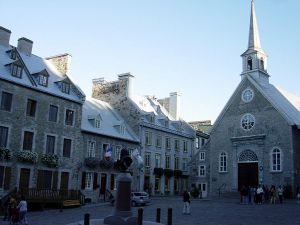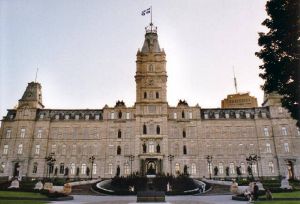Difference between revisions of "Quebec City" - New World Encyclopedia
Scott Dunbar (talk | contribs) m |
Scott Dunbar (talk | contribs) |
||
| Line 8: | Line 8: | ||
|settlement_type = <!--For Town or Village (Leave blank for the default City)—> | |settlement_type = <!--For Town or Village (Leave blank for the default City)—> | ||
|motto = Don de Dieu feray valoir <br/>(I shall put God's gift to good use) | |motto = Don de Dieu feray valoir <br/>(I shall put God's gift to good use) | ||
| − | |image_skyline = | + | |image_skyline = Ville de Québec vu de Lévis.jpg |
| − | |||
| − | |||
| − | |||
| − | |||
| − | |||
| − | |||
| − | |||
| − | |||
| − | |||
| − | |||
|image_map = Qc-quebeccity.PNG | |image_map = Qc-quebeccity.PNG | ||
|mapsize = 300px | |mapsize = 300px | ||
| Line 46: | Line 36: | ||
|established_date2 = 1833 | |established_date2 = 1833 | ||
|established_title3 = <!-- Incorporated (city) —> | |established_title3 = <!-- Incorporated (city) —> | ||
| − | |||
|area_magnitude = | |area_magnitude = | ||
| + | |area_total = 542.71 km | ||
|unit_pref = <!--Enter: Imperial, if Imperial (metric) is desired—> | |unit_pref = <!--Enter: Imperial, if Imperial (metric) is desired—> | ||
|area_footnotes = | |area_footnotes = | ||
| − | |area_total_km2 = 542.71 | + | |area_total_km2 = 542.71 km |
| − | |||
| − | |||
| − | |||
| − | |||
| − | |||
| − | |||
| − | |||
| − | |||
| − | |||
| − | |||
|population_as_of = 2006, 2001*, 2005** | |population_as_of = 2006, 2001*, 2005** | ||
|population_footnotes = | |population_footnotes = | ||
| Line 83: | Line 63: | ||
|latd=46 |latm=48 |lats= |latNS=N | |latd=46 |latm=48 |lats= |latNS=N | ||
|longd=71 |longm=23 |longs= |longEW=W | |longd=71 |longm=23 |longs= |longEW=W | ||
| − | |||
| − | |||
| − | |||
|postal_code_type = <!-- enter ZIP code, Postcode, Post code, Postal code... —> | |postal_code_type = <!-- enter ZIP code, Postcode, Post code, Postal code... —> | ||
|postal_code = | |postal_code = | ||
| Line 97: | Line 74: | ||
}} <!-- Infobox ends —> | }} <!-- Infobox ends —> | ||
| − | '''Quebec City''' or '''Québec''' ([[French language|French]]: ''Ville de Québec'', or simply ''Québec'') is the [[capital]] of the [[Canada|Canadian]] [[Provinces and territories of Canada|province]] of [[Quebec]]. It is the second largest city in the province, after [[Montreal]]. Quebec's Old Town (''Vieux-Québec''), the only [[North America]]n fortified city north of [[Mexico]] whose walls still exist, was declared a [[World Heritage Site]] by the [[United Nations]] Educational, Scientific and Cultural Organization (UNESCO) in 1985 as the "Historic District of Old Quebec." It is also one of the oldest cities in North America. The city has a population of 528,595, and the metropolitan area has a population of 717,600 (2005). | + | '''Quebec City''' or '''Québec''' ([[French language|French]]: ''Ville de Québec'', or simply ''Québec'')<ref>''Kébec'' is the [[Algonquin]] word meaning "where the river narrows."</ref> is the [[capital]] of the [[Canada|Canadian]] [[Provinces and territories of Canada|province]] of [[Quebec]]. It is the second largest city in the province, after [[Montreal]]. Quebec's Old Town (''Vieux-Québec''), the only [[North America]]n fortified city north of [[Mexico]] whose walls still exist, was declared a [[World Heritage Site]] by the [[United Nations]] Educational, Scientific and Cultural Organization (UNESCO) in 1985 as the "Historic District of Old Quebec." It is also one of the oldest cities in North America. The city has a population of 528,595, and the metropolitan area has a population of 717,600 (2005). |
Quebec City is known for its Winter Carnival and the Château Frontenac, a historic hotel which dominates the city skyline. The National Assembly of Quebec (provincial parliament), the ''Musée national des beaux-arts du Québec'' (National Museum of Fine Arts) and the Museum of Civilization are found within or near Vieux-Québec. | Quebec City is known for its Winter Carnival and the Château Frontenac, a historic hotel which dominates the city skyline. The National Assembly of Quebec (provincial parliament), the ''Musée national des beaux-arts du Québec'' (National Museum of Fine Arts) and the Museum of Civilization are found within or near Vieux-Québec. | ||
| Line 106: | Line 83: | ||
[[Image:Samuel de champlain.jpg|thumb|left|Traditional representation of [[Samuel de Champlain]].]] | [[Image:Samuel de champlain.jpg|thumb|left|Traditional representation of [[Samuel de Champlain]].]] | ||
| − | |||
| − | |||
| − | |||
| − | |||
| − | |||
Quebec City is one of the oldest settlements in North America. While many of the major cities in [[Mexico]] date from the sixteenth century, among cities in the U.S. and Canada only [[St. John's, Newfoundland and Labrador]], Port Royal, [[Nova Scotia]], St. Augustine, Florida, Santa Fe, New Mexico, and Tadoussac, Quebec were created earlier than Quebec. However Quebec city is the first to have been founded with the explicit goal of receiving permanent settlement, and not as a commercial outpost, and therefore is considered to be the first European-built [[city]] in non-Spanish North America. | Quebec City is one of the oldest settlements in North America. While many of the major cities in [[Mexico]] date from the sixteenth century, among cities in the U.S. and Canada only [[St. John's, Newfoundland and Labrador]], Port Royal, [[Nova Scotia]], St. Augustine, Florida, Santa Fe, New Mexico, and Tadoussac, Quebec were created earlier than Quebec. However Quebec city is the first to have been founded with the explicit goal of receiving permanent settlement, and not as a commercial outpost, and therefore is considered to be the first European-built [[city]] in non-Spanish North America. | ||
| Line 121: | Line 93: | ||
Quebec City was captured by the British in 1759 and held until 1763. It was the site of the [[Battle of the Plains of Abraham]] during the [[Seven Years' War]], in which British troops under General [[James Wolfe]] defeated the French general [[Louis-Joseph de Montcalm]] and took the city. France later ceded [[New France]] to Britain. | Quebec City was captured by the British in 1759 and held until 1763. It was the site of the [[Battle of the Plains of Abraham]] during the [[Seven Years' War]], in which British troops under General [[James Wolfe]] defeated the French general [[Louis-Joseph de Montcalm]] and took the city. France later ceded [[New France]] to Britain. | ||
| − | |||
During the [[American Revolution]], revolutionary troops from the southern colonies assaulted the British garrison in a futile attempt to liberate Quebec City now known as the [[Battle of Quebec (1775)|Battle of Quebec]]. The defeat of the revolutionaries from the south put an end to the hopes that the peoples of Quebec would rise and join the Revolution. Major General [[Isaac Brock]] fortified Quebec City by strengthening the walls and building an elevated [[artillery]] battery before the [[War of 1812]]. | During the [[American Revolution]], revolutionary troops from the southern colonies assaulted the British garrison in a futile attempt to liberate Quebec City now known as the [[Battle of Quebec (1775)|Battle of Quebec]]. The defeat of the revolutionaries from the south put an end to the hopes that the peoples of Quebec would rise and join the Revolution. Major General [[Isaac Brock]] fortified Quebec City by strengthening the walls and building an elevated [[artillery]] battery before the [[War of 1812]]. | ||
In 1840, after the Province of Canada was formed, the capital was shared between Kingston, [[Montreal]], [[Toronto]], [[Ottawa]] and Quebec City (from 1852 to 1856 and from 1859 to 1866). In 1867, Ottawa (which was chosen to be the permanent capital of the Province of Canada) was chosen to be the capital of the Dominion of Canada. The Quebec Conference on Canadian Confederation was held here. | In 1840, after the Province of Canada was formed, the capital was shared between Kingston, [[Montreal]], [[Toronto]], [[Ottawa]] and Quebec City (from 1852 to 1856 and from 1859 to 1866). In 1867, Ottawa (which was chosen to be the permanent capital of the Province of Canada) was chosen to be the capital of the Dominion of Canada. The Quebec Conference on Canadian Confederation was held here. | ||
| − | |||
In [[World War II]], two conferences were held in Quebec City. The first one was held in 1943 with [[Franklin Delano Roosevelt]] (the [[United States]]' president), [[Winston Churchill]] (the [[United Kingdom]]'s prime minister), [[William Lyon Mackenzie King]] (Canada's prime minister) and [[T.V. Soong]] ([[China]]'s minister of foreign affairs). The second one was held in 1944, and was attended by Churchill and Roosevelt. They took place in the buildings of the Citadelle and of nearby [[Château Frontenac]]. A large part of the [[D-Day]] Landings plans were made during those meetings. | In [[World War II]], two conferences were held in Quebec City. The first one was held in 1943 with [[Franklin Delano Roosevelt]] (the [[United States]]' president), [[Winston Churchill]] (the [[United Kingdom]]'s prime minister), [[William Lyon Mackenzie King]] (Canada's prime minister) and [[T.V. Soong]] ([[China]]'s minister of foreign affairs). The second one was held in 1944, and was attended by Churchill and Roosevelt. They took place in the buildings of the Citadelle and of nearby [[Château Frontenac]]. A large part of the [[D-Day]] Landings plans were made during those meetings. | ||
| Line 154: | Line 124: | ||
==Municipal public administration== | ==Municipal public administration== | ||
[[Image:VieuxQuebec 2003-0427 VueDeLaVieilleVilleEtDeLaCitadelle.jpg|thumb|right|Old Quebec, the walled city.]] | [[Image:VieuxQuebec 2003-0427 VueDeLaVieilleVilleEtDeLaCitadelle.jpg|thumb|right|Old Quebec, the walled city.]] | ||
| − | |||
| − | |||
[[Image:Hoteldevilledequebec.jpg|thumb|right|City Hall of Quebec City]] | [[Image:Hoteldevilledequebec.jpg|thumb|right|City Hall of Quebec City]] | ||
| − | |||
| − | |||
| − | |||
| − | |||
| − | |||
| − | |||
| − | |||
| − | |||
| − | |||
| − | |||
| − | |||
| − | |||
| − | |||
| − | |||
| − | |||
| − | |||
| − | |||
| − | |||
| − | |||
| − | |||
| − | |||
| − | |||
| − | |||
| − | |||
| − | |||
| − | |||
| − | |||
| − | |||
| − | |||
| − | |||
| − | |||
| − | |||
| − | |||
| − | |||
| − | |||
| − | |||
| − | |||
| − | |||
| − | |||
| − | |||
| − | |||
| − | |||
| − | |||
| − | |||
| − | |||
| − | |||
| − | |||
| − | |||
| − | |||
| − | |||
| − | |||
| − | |||
| − | |||
| − | |||
| − | |||
| − | |||
| − | |||
| − | |||
| − | |||
| − | |||
| − | |||
| − | |||
| − | |||
| − | |||
| − | |||
| − | |||
| − | |||
| − | |||
| − | |||
| − | |||
| − | |||
| − | |||
| − | |||
| − | |||
| − | |||
| − | |||
| − | |||
| − | |||
| − | |||
| − | |||
| − | |||
| − | |||
| − | |||
| − | |||
| − | |||
| − | |||
| − | |||
| − | |||
| − | |||
| − | |||
| − | |||
| − | |||
| − | |||
| − | |||
| − | |||
| − | |||
| − | |||
| − | |||
==Demographics== | ==Demographics== | ||
| Line 298: | Line 168: | ||
==Transportation== | ==Transportation== | ||
[[Image:Quebec City 03.jpg|right|thumb|The Lower Town by the river]] | [[Image:Quebec City 03.jpg|right|thumb|The Lower Town by the river]] | ||
| − | Quebec City is served by | + | Quebec City is served by Jean Lesage International Airport, located in the West of the city. [http://www.aeroportdequebec.com/index_en.php] |
| − | The city also has a large major | + | The city also has a large major port on the St-Lawrence in the first, fifth and sixth boroughs. [http://www.portquebec.ca/en/main.asp Web site] |
| − | Three bridges, the | + | Three bridges, the Quebec Bridge and Pierre Laporte Bridge connect the city with the south shore of the Saint Lawrence River, as does a [[ferry]] service to Lévis, and Orleans Island Bridge connects Quebec City with the Orleans Island. The city is a major hub in the Quebec provincial road network, fanning out from both sides of the river with an extensive autoroute system. |
| − | Several important motorways of the Quebec road network pass by Quebec City, of which | + | Several important motorways of the Quebec road network pass by Quebec City, of which Autoroute 40 connects it towards the west to Montreal and Route 175 connects it towards the north to Chicoutimi. |
| − | Three principal expressways cross the agglomeration from the north to the south (starting from the west): | + | Three principal expressways cross the agglomeration from the north to the south (starting from the west): Autoroute Henri-IV, Autoroute Robert-Bourassa, and Autoroute Laurentienne. Three other motorways cross the western part of town (from north to south): Autoroute Félix Leclerc (known by the inhabitants as "Autoroute de la Capitale"), Autoroute Charest, as well as Champlain Boulevard, which goes along the river to the Downtown area, then another Autoroute called Dufferin-Montmorency allows easier access to the extreme east of the city. |
| − | The city is served by | + | The city is served by VIA Rail (Gare du Palais), and is the eastern terminus of the railway's main Quebec City-Windsor Corridor. The bus station, with connections to the provincial long-distance bus network, is also in the same location. |
| − | The | + | The Réseau de transport de la Capitale is responsible for public transportation by bus. [http://www.rtcquebec.ca Web site in French only] |
An overdependence on autos leaves little room for cyclists on the roads. They are generally forced into autos as in most American cities, detracting from the European character of the city. | An overdependence on autos leaves little room for cyclists on the roads. They are generally forced into autos as in most American cities, detracting from the European character of the city. | ||
=== Public safety === | === Public safety === | ||
| − | Quebec City is protected by | + | Quebec City is protected by Service de police de la Ville de Québec and Service de protection contre les incendies de Québec. |
==Attractions== | ==Attractions== | ||
| − | [[Image:Chateau Frontenac in Halifax.jpg|right|thumb| | + | [[Image:Chateau Frontenac in Halifax.jpg|right|thumb|Château Frontenac, Haute-Ville (Upper Town).]] |
[[Image:QuebecCitySum04.jpg|right|thumb|Notre Dame des Victoires church, Basse-Ville (Lower Town).]] | [[Image:QuebecCitySum04.jpg|right|thumb|Notre Dame des Victoires church, Basse-Ville (Lower Town).]] | ||
| − | Many of the city's attractions are east of the fortification walls in | + | Many of the city's attractions are east of the fortification walls in Vieux-Québec (Old Quebec). This area has a distinct European feel unique in North America with its stone buildings and winding streets lined with shops and restaurants. Porte St-Louis (St. Louis Gate) and Porte St-Jean (St. Jean Gate) are the main gates through the walls from the modern section of downtown. West of the walls are the Colline-Parlementaire (Parliament Hill) district and the Plaines d'Abraham (Plains of Abraham). |
| − | Quebec City's skyline is dominated by the massive | + | Quebec City's skyline is dominated by the massive Château Frontenac Hotel, perched on top of Cap-Diamant. The hotel is beside the Terrasse Dufferin (Dufferin Terrace), a walkway along the edge of the cliff, offering beautiful views of the Saint Lawrence River. |
| − | Near the Château Frontenac is | + | Near the Château Frontenac is Notre-Dame de Québec Cathedral, mother church of the Roman Catholic Archdiocese of Quebec. It is the first church in the [[New World]] to be raised to a [[basilica]] and is the primatial church of Canada. |
| − | The Terrasse Dufferin leads toward the nearby [[Plains of Abraham]], site of the battle in which the [[United Kingdom|British]] took Quebec from [[France]], and the | + | The Terrasse Dufferin leads toward the nearby [[Plains of Abraham]], site of the battle in which the [[United Kingdom|British]] took Quebec from [[France]], and the Citadelle of Quebec, a Canadian Forces installation and the federal vice-regal secondary residence. The National Assembly, Quebec's provincial legislature, is also near the Citadelle. |
| − | The Haute-Ville (Upper Town) is linked by the Escalier ''«casse-cou»'' (literally "neck-breaker" steps) and the | + | The Haute-Ville (Upper Town) is linked by the Escalier ''«casse-cou»'' (literally "neck-breaker" steps) and the Old Quebec Funicular to the Basse-Ville (Lower Town), which includes such sites as the ancient Notre Dame des Victoires church, the historic Petit Champlain district, the port, and the Musée de la Civilisation (Museum of Civilization). Université Laval is located in the western end of the city, in the borough of Sainte-Foy. However, the school of architecture of Université Laval is located in Old Quebec. The central campus of the Université du Québec is also located in Quebec City. |
Canon balls are placed beside "Château Frontenac." | Canon balls are placed beside "Château Frontenac." | ||
| − | Quebec City is known for its | + | Quebec City is known for its Winter Carnival and for its Saint-Jean-Baptiste Day celebrations. |
| − | Tourist attractions located near Quebec City include | + | Tourist attractions located near Quebec City include Montmorency Falls and the Basilica of Sainte-Anne-de-Beaupré. |
===Museums=== | ===Museums=== | ||
| Line 348: | Line 218: | ||
*[http://www.ccbn-nbc.gc.ca= Plains of Abraham Exhibition Center] | *[http://www.ccbn-nbc.gc.ca= Plains of Abraham Exhibition Center] | ||
| − | |||
| − | |||
[[Image:L'Assemblée Nationale du Québec.jpg|thumb|right|[[National Assembly of Quebec|National Assembly]], Quebec City.]] | [[Image:L'Assemblée Nationale du Québec.jpg|thumb|right|[[National Assembly of Quebec|National Assembly]], Quebec City.]] | ||
| − | |||
| − | |||
| − | |||
| − | |||
| − | |||
| − | |||
| − | |||
| − | |||
| − | |||
| − | |||
| − | |||
| − | |||
| − | |||
| − | |||
| − | |||
| − | |||
| − | |||
| − | |||
| − | |||
| − | |||
| − | |||
| − | |||
| − | |||
| − | |||
| − | |||
| − | |||
| − | |||
| − | |||
| − | |||
| − | |||
| − | |||
| − | |||
| − | |||
| − | |||
| − | |||
| − | |||
| − | |||
| − | |||
===Natural science sites=== | ===Natural science sites=== | ||
* Jardin zoologique du Québec, reopened in 2002 after two years of restorations but closed in 2006 after a political decision. It was presenting to the public 750 specimens of 300 different species. The zoo was specialized in winged fauna and garden themes, but also presented several species of mammals. While it emphasizes the indigenous fauna of Quebec, one of its principal attractions was the Indo-Australian greenhouse, featuring fauna and flora from these areas. | * Jardin zoologique du Québec, reopened in 2002 after two years of restorations but closed in 2006 after a political decision. It was presenting to the public 750 specimens of 300 different species. The zoo was specialized in winged fauna and garden themes, but also presented several species of mammals. While it emphasizes the indigenous fauna of Quebec, one of its principal attractions was the Indo-Australian greenhouse, featuring fauna and flora from these areas. | ||
| − | * | + | * Parc Aquarium du Quebec, reopened in 2002 on a site overlooking the [[St. Lawrence River]], presents more than 10,000 specimens of mammals, reptiles, fish and other aquatic fauna of North America and the [[Arctic]]. [[Polar bear]]s and various species of [[Pinniped|seal]]s of the Arctic sector and the "Large Ocean," a large basin offering visitors a view from underneath, form part of the principal attractions. Website : http://www.spsnq.qc.ca/ |
==Post-secondary education== | ==Post-secondary education== | ||
| + | Quebec city has a number of centers of higher learning including the famous Université Laval (Univerity of Laval) and several smaller community colleges. The vast majority of these instituions offer their classes in French, which is the dominant language of instruction in the province of Quebec. A list of these post-secondary institutions is found below: | ||
{{col-begin}} | {{col-begin}} | ||
{{col-break}} | {{col-break}} | ||
'''University level''' | '''University level''' | ||
| − | * | + | * Université Laval |
| − | * | + | * Université du Québec (Headquarters of the network) |
| − | * | + | * École nationale d'administration publique (ENAP) |
| − | * | + | * Institut national de la recherche scientifique (INRS) |
| − | * | + | * Télé-université (TELUQ) |
| + | |||
{{col-break}} | {{col-break}} | ||
'''College level''' | '''College level''' | ||
| Line 411: | Line 243: | ||
** Campus of 4th borough | ** Campus of 4th borough | ||
** Campus of the "Maison des métiers d'art de Québec" | ** Campus of the "Maison des métiers d'art de Québec" | ||
| − | * | + | * Cégep de Sainte-Foy |
* Collège Notre-Dame-de-Foy | * Collège Notre-Dame-de-Foy | ||
* Collège Mérici | * Collège Mérici | ||
| Line 417: | Line 249: | ||
* Collège CDI | * Collège CDI | ||
* Collège Multihexa | * Collège Multihexa | ||
| − | * | + | * Champlain-St. Lawrence College (English-speaking Cégep) |
{{col-end}} | {{col-end}} | ||
== Notes == | == Notes == | ||
<references/> | <references/> | ||
| + | |||
| + | ==References== | ||
| + | * Grignon, Marc.''Loing Du Soleil: Architectural Practice in Quebec City During the French Regime.'' Peter Lang Publishing, 1997. ISBN 978-0820425153 | ||
| + | * Linteau, Paul-André, René Durocher and Jean-Claude Robert with Robert Chodos (Translator) ''Quebec: A History 1867-1929.'' Lorimer, 1983. ISBN 978-0888626042 | ||
| + | * Lessard, Michel and Claudel Huot (Photographer) ''Quebec: City of Light.'' Les Edition de L'Homme, 2004. ISBN 978-2761916431 | ||
| + | * Ruddel, David Thiery. ''Quebec City, 1765-1832: The Evolution of a Colonial Town.'' Canadian Museum of Civilization, 1988. ISBN 978-0660107714 | ||
== External links == | == External links == | ||
Revision as of 22:55, 28 June 2007
| Quebec City, Quebec Ville de Québec, Québec |
|
| Motto: Don de Dieu feray valoir (I shall put God's gift to good use) |
|
| Site in the province of Quebec | |
| Coordinates: 46°48′N 71°23′W | |
|---|---|
| Country | Canada |
| Province | Quebec |
| Agglomeration | Quebec City |
| Founded | 1608 by Samuel de Champlain |
| Constitution date | 1833 |
| Area | |
| - City | 542.71 km km² (Expression error: Unrecognized word "km". sq mi) |
| Population (2006, 2001*, 2005**) | |
| - City | 491,142 (Ranked 10th) |
| - Metro | 717,600* |
| - Quebec City Area | 1,064,047** |
| Time zone | Eastern (UTC-5) |
| Area code(s) | 418 |
| Geographical code | 24 23027 |
| Website: Official website of Quebec City | |
Quebec City or Québec (French: Ville de Québec, or simply Québec)[1] is the capital of the Canadian province of Quebec. It is the second largest city in the province, after Montreal. Quebec's Old Town (Vieux-Québec), the only North American fortified city north of Mexico whose walls still exist, was declared a World Heritage Site by the United Nations Educational, Scientific and Cultural Organization (UNESCO) in 1985 as the "Historic District of Old Quebec." It is also one of the oldest cities in North America. The city has a population of 528,595, and the metropolitan area has a population of 717,600 (2005).
Quebec City is known for its Winter Carnival and the Château Frontenac, a historic hotel which dominates the city skyline. The National Assembly of Quebec (provincial parliament), the Musée national des beaux-arts du Québec (National Museum of Fine Arts) and the Museum of Civilization are found within or near Vieux-Québec.
Among the tourist attractions in the city are Montmorency Falls and the Basilica of Sainte-Anne-de-Beaupré in the town of Beaupré.
History
Quebec City is one of the oldest settlements in North America. While many of the major cities in Mexico date from the sixteenth century, among cities in the U.S. and Canada only St. John's, Newfoundland and Labrador, Port Royal, Nova Scotia, St. Augustine, Florida, Santa Fe, New Mexico, and Tadoussac, Quebec were created earlier than Quebec. However Quebec city is the first to have been founded with the explicit goal of receiving permanent settlement, and not as a commercial outpost, and therefore is considered to be the first European-built city in non-Spanish North America.
Quebec was founded by Samuel de Champlain on 3 July 1608 at the site of a long abandoned St. Lawrence Iroquoian settlement called Stadacona. It was to this settlement that the name "Canada" refers. It is the cradle of the Francophone population in North America. The place seemed favourable to the establishment of a permanent colony.
Before Champlain, French explorer Jacques Cartier built a fort at the site in 1535, where he stayed for the winter before going back to France in spring 1536. He came back in 1541 with the goal of building a permanent settlement. This first settlement was abandoned less than one year after its foundation, in the summer 1542, due in large part to the hostility of the natives combined with the harsh living conditions during winter.
At the end of French rule in 1763, the territory of present-day Quebec City was a world of contrasts. Forests, villages, fields and pastures surrounded the town of 8 000 inhabitants. The town distinguished itself by its monumental architecture, fortifications, muddy and filthy streets, affluent homes of masonry and shacks in the suburbs St-Jean and St-Roch. Despite its urbanity and its status as capital, Quebec City remained a small colonial city with close ties to its rural surroundings. Nearby inhabitants traded their farm surpluses and firewood for imported goods from France at the two city markets.
Quebec City was captured by the British in 1759 and held until 1763. It was the site of the Battle of the Plains of Abraham during the Seven Years' War, in which British troops under General James Wolfe defeated the French general Louis-Joseph de Montcalm and took the city. France later ceded New France to Britain.
During the American Revolution, revolutionary troops from the southern colonies assaulted the British garrison in a futile attempt to liberate Quebec City now known as the Battle of Quebec. The defeat of the revolutionaries from the south put an end to the hopes that the peoples of Quebec would rise and join the Revolution. Major General Isaac Brock fortified Quebec City by strengthening the walls and building an elevated artillery battery before the War of 1812.
In 1840, after the Province of Canada was formed, the capital was shared between Kingston, Montreal, Toronto, Ottawa and Quebec City (from 1852 to 1856 and from 1859 to 1866). In 1867, Ottawa (which was chosen to be the permanent capital of the Province of Canada) was chosen to be the capital of the Dominion of Canada. The Quebec Conference on Canadian Confederation was held here.
In World War II, two conferences were held in Quebec City. The first one was held in 1943 with Franklin Delano Roosevelt (the United States' president), Winston Churchill (the United Kingdom's prime minister), William Lyon Mackenzie King (Canada's prime minister) and T.V. Soong (China's minister of foreign affairs). The second one was held in 1944, and was attended by Churchill and Roosevelt. They took place in the buildings of the Citadelle and of nearby Château Frontenac. A large part of the D-Day Landings plans were made during those meetings.
Capital
Throughout its nearly four hundred years of existence, Quebec City has served as a capital:
- from 1608 to 1627 and 1632 to 1763, it was capital of French Canada and all of New France,
- from 1763 to 1791, it was the capital of the Province of Quebec,
- from 1791 to 1841, it was the capital of the Province of Lower Canada,
- from 1852 to 1856 and from 1859 to 1866, it was capital of the Province of Canada,
- from 1867 to today, it has been capital of the Province of Quebec.
It is also the principal city of the Agglomeration of Quebec City, the Greater Quebec City Area, the administrative region of Capitale-Nationale, and the Quebec City Area.
French/English nomenclature
The city is called Québec (with an acute accent) by both the provincial and federal governments in both languages. To differentiate between Quebec the city and Quebec the province in English, the city is commonly referred to as "Quebec City" while the province is referred to as "Quebec." It is common for the accent to be dropped in English texts.
In French, Quebec City is generally referred to simply as "Québec" without the French equivalent of the word "city." French names of large geographical regions such as provinces and countries are typically preceded by articles whereas city names are not (unless it is part of the name, such as "La Malbaie"). As a result, the province is called le Québec ("in Quebec" = au Québec, from Quebec = du Québec) while the city is simply Québec ("in Quebec City" is à Québec, "from Quebec City" = de Québec).
The official legal, corporate name of the city is Ville de Québec in both languages.[1] In the English section of Quebec City's official website, the city is referred to as "Québec City" (with the acute accent over the 'e').
In French, residents of Quebec City are called Québécois (male) or Québécoise (female). To avoid confusion with Québécois/e meaning an inhabitant of the province, the term Québécois/e de Québec for residents of the city is sometimes used (as opposed to Québécois/e du Québec, resident of the province). In English, the term Quebecer (or Quebecker) is sometimes used, but use of the French Québécois or Québécoise is increasingly common.
Also, Quebec City is sometimes referred to as "la capitale nationale" ("the national capital"). The government officially named it this way under the Union Nationale party. |Its region bears this name as well. It should be noted, however, that the word national in this sense refers to Quebec as a nation, or distinct group, within the country of Canada, and has no official indication of sovereignty[2].
Municipal public administration
Demographics
According to the last (May 2001) census, there were 682,757 people residing in Quebec City, of whom 48.2% were male and 51.8% were female. Children under five accounted for approximately 4.7% of the resident population of Quebec City. This compares with 5.2% in the province of Quebec, and 5.6% for Canada overall.
While Montreal is considered by many to be a bilingual city, with many of its residents having a working knowledge of both French and English, Quebec City and its surrounding region is largely Francophone. The large majority of city residents are native French-speakers.
In mid-2001, 13.0% of the resident population in Quebec City was of retirement age (65 and over for males and females) compared with 13.2% in Canada. The average age is 39.5 years of age compared to 37.6 years of age for Canada as a whole.
In the five years between 1996 and 2001, the population of Quebec City grew by 1.6%, compared with an increase of 1.4% for the province of Quebec as a whole. Population density of Quebec City averaged 216.4 people per square kilometre, compared with an average of 5.3, for the province of Quebec as a whole.
At the time of that May 2001 census, the population of the Quebec City authority was 682,757, but was 710,700 when encompassing the Greater Quebec City Area, compared with a resident population in the province of Quebec of 7,237,479 people.
According to the 2001 census, over 90% of the population was Roman Catholic, along with small Jewish and Protestant populations.
| 1931 | 1941 | 1951 | 1961 | 1971 | 1981 | 1991 | 2001 | 2006 |
|---|---|---|---|---|---|---|---|---|
| 131 000 | 151 000 | 289 000 | 379 000 | 481 000 | 576 000 | 646 000 | 683 000 | 720 000 |
Transportation
Quebec City is served by Jean Lesage International Airport, located in the West of the city. [2]
The city also has a large major port on the St-Lawrence in the first, fifth and sixth boroughs. Web site
Three bridges, the Quebec Bridge and Pierre Laporte Bridge connect the city with the south shore of the Saint Lawrence River, as does a ferry service to Lévis, and Orleans Island Bridge connects Quebec City with the Orleans Island. The city is a major hub in the Quebec provincial road network, fanning out from both sides of the river with an extensive autoroute system.
Several important motorways of the Quebec road network pass by Quebec City, of which Autoroute 40 connects it towards the west to Montreal and Route 175 connects it towards the north to Chicoutimi.
Three principal expressways cross the agglomeration from the north to the south (starting from the west): Autoroute Henri-IV, Autoroute Robert-Bourassa, and Autoroute Laurentienne. Three other motorways cross the western part of town (from north to south): Autoroute Félix Leclerc (known by the inhabitants as "Autoroute de la Capitale"), Autoroute Charest, as well as Champlain Boulevard, which goes along the river to the Downtown area, then another Autoroute called Dufferin-Montmorency allows easier access to the extreme east of the city.
The city is served by VIA Rail (Gare du Palais), and is the eastern terminus of the railway's main Quebec City-Windsor Corridor. The bus station, with connections to the provincial long-distance bus network, is also in the same location.
The Réseau de transport de la Capitale is responsible for public transportation by bus. Web site in French only
An overdependence on autos leaves little room for cyclists on the roads. They are generally forced into autos as in most American cities, detracting from the European character of the city.
Public safety
Quebec City is protected by Service de police de la Ville de Québec and Service de protection contre les incendies de Québec.
Attractions
Many of the city's attractions are east of the fortification walls in Vieux-Québec (Old Quebec). This area has a distinct European feel unique in North America with its stone buildings and winding streets lined with shops and restaurants. Porte St-Louis (St. Louis Gate) and Porte St-Jean (St. Jean Gate) are the main gates through the walls from the modern section of downtown. West of the walls are the Colline-Parlementaire (Parliament Hill) district and the Plaines d'Abraham (Plains of Abraham).
Quebec City's skyline is dominated by the massive Château Frontenac Hotel, perched on top of Cap-Diamant. The hotel is beside the Terrasse Dufferin (Dufferin Terrace), a walkway along the edge of the cliff, offering beautiful views of the Saint Lawrence River.
Near the Château Frontenac is Notre-Dame de Québec Cathedral, mother church of the Roman Catholic Archdiocese of Quebec. It is the first church in the New World to be raised to a basilica and is the primatial church of Canada.
The Terrasse Dufferin leads toward the nearby Plains of Abraham, site of the battle in which the British took Quebec from France, and the Citadelle of Quebec, a Canadian Forces installation and the federal vice-regal secondary residence. The National Assembly, Quebec's provincial legislature, is also near the Citadelle.
The Haute-Ville (Upper Town) is linked by the Escalier «casse-cou» (literally "neck-breaker" steps) and the Old Quebec Funicular to the Basse-Ville (Lower Town), which includes such sites as the ancient Notre Dame des Victoires church, the historic Petit Champlain district, the port, and the Musée de la Civilisation (Museum of Civilization). Université Laval is located in the western end of the city, in the borough of Sainte-Foy. However, the school of architecture of Université Laval is located in Old Quebec. The central campus of the Université du Québec is also located in Quebec City. Canon balls are placed beside "Château Frontenac."
Quebec City is known for its Winter Carnival and for its Saint-Jean-Baptiste Day celebrations.
Tourist attractions located near Quebec City include Montmorency Falls and the Basilica of Sainte-Anne-de-Beaupré.
Museums
- Musée national des beaux-arts du Québec
- Musée de la civilisation
- Musée de l'Amérique française
- Espace Félix Leclerc
- Musée naval de Québec
- Choco-Musée Erico
- Musée des Ursulines de Québec
- Musée du Royal 22e Régiment/La Citadelle de Quebéc
- Musée Québec Expérience
- Musée de l'Abeille
- Plains of Abraham Exhibition Center
Natural science sites
- Jardin zoologique du Québec, reopened in 2002 after two years of restorations but closed in 2006 after a political decision. It was presenting to the public 750 specimens of 300 different species. The zoo was specialized in winged fauna and garden themes, but also presented several species of mammals. While it emphasizes the indigenous fauna of Quebec, one of its principal attractions was the Indo-Australian greenhouse, featuring fauna and flora from these areas.
- Parc Aquarium du Quebec, reopened in 2002 on a site overlooking the St. Lawrence River, presents more than 10,000 specimens of mammals, reptiles, fish and other aquatic fauna of North America and the Arctic. Polar bears and various species of seals of the Arctic sector and the "Large Ocean," a large basin offering visitors a view from underneath, form part of the principal attractions. Website : http://www.spsnq.qc.ca/
Post-secondary education
Quebec city has a number of centers of higher learning including the famous Université Laval (Univerity of Laval) and several smaller community colleges. The vast majority of these instituions offer their classes in French, which is the dominant language of instruction in the province of Quebec. A list of these post-secondary institutions is found below:
|
University level
|
College level
|
Notes
- ↑ Kébec is the Algonquin word meaning "where the river narrows."
- ↑ House passes motion recognizing Québécois as nation. CBC.ca. Retrieved 2007-03-24.
ReferencesISBN links support NWE through referral fees
- Grignon, Marc.Loing Du Soleil: Architectural Practice in Quebec City During the French Regime. Peter Lang Publishing, 1997. ISBN 978-0820425153
- Linteau, Paul-André, René Durocher and Jean-Claude Robert with Robert Chodos (Translator) Quebec: A History 1867-1929. Lorimer, 1983. ISBN 978-0888626042
- Lessard, Michel and Claudel Huot (Photographer) Quebec: City of Light. Les Edition de L'Homme, 2004. ISBN 978-2761916431
- Ruddel, David Thiery. Quebec City, 1765-1832: The Evolution of a Colonial Town. Canadian Museum of Civilization, 1988. ISBN 978-0660107714
External links
- Tourist information of the Quebec city area Retrieved June 25, 2007.
- Official website of Quebec City Retrieved June 25, 2007.
- Official website of Quebec City Tourism Retrieved June 25, 2007.
- Quebec City Guide - Télégraphe de Québec Retrieved June 25, 2007.
- Quebec City on Google Maps Retrieved June 25, 2007.
- Buildings of Quebec City Retrieved June 25, 2007.
- Quebec 2008 (400th Anniversary) Retrieved June 25, 2007.
- Parc technologique du Québec métropolitain (French) Retrieved June 25, 2007.
- Municipal election in Quebec City - Radio-Canada.ca (French) Retrieved June 25, 2007.
- Quebec politics (French) Retrieved June 25, 2007.
- Website of the firemen of Quebec City (French) Retrieved June 25, 2007.
- Quebec's Old Town Photo Tour Retrieved June 25, 2007.
- Quebec City Pictures Retrieved June 25, 2007.
Credits
New World Encyclopedia writers and editors rewrote and completed the Wikipedia article in accordance with New World Encyclopedia standards. This article abides by terms of the Creative Commons CC-by-sa 3.0 License (CC-by-sa), which may be used and disseminated with proper attribution. Credit is due under the terms of this license that can reference both the New World Encyclopedia contributors and the selfless volunteer contributors of the Wikimedia Foundation. To cite this article click here for a list of acceptable citing formats.The history of earlier contributions by wikipedians is accessible to researchers here:
The history of this article since it was imported to New World Encyclopedia:
Note: Some restrictions may apply to use of individual images which are separately licensed.
